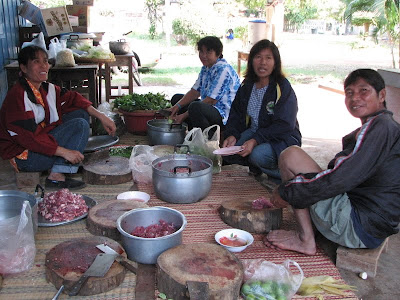
I catch two mini-buses (when they decide to stop for me) to get there or walk from Takisila dormitory to the back entrance of the old campus where I am always given a lift by someone to the front gate where my classes are held. There is something about the old 
Across the road from the building where I take classes the yellow mini-buses and their drivers stop before the return journey to the new campus. There is a big old tree which is perfectly positioned to create 
The tree is very old (nobody can tell me HOW old) and even though it looks like a stand of trees it is only one tree. I am assuming it is a Rajaphreuk (Cassia ) tree, which is the representative tree of Mahasarakham University. The yellow flowers represent Thai Royalty and are the national flower of Thailand. For a little trivia it is also the State flower of Kerala in the south of India.
I also know it creates a wonderful welcoming cool shade under the hot Mahasarakham sun and makes the at times very tedious wait for the mini bus to move off a rare enjoyable experience.
Looking from the balcony of the classroom you cannot see the singular paved pathway leading into the centre of the tree. To enter here is to walk into a different world for here you find what some would describe as a temple but I choose to describe as a house for a very good reason.
Many westerners assume Therevada Buddhism is and has been for what seems forever the predominant form of worship (for want of a better word) in the north east of Thailand. It does not exist alone. Perhaps even before the good Lord Buddha left his indelible print on Isan people there existed a form of animism worship with the two existing quite harmoniously (see Animism in Laos ).
The practitioners of animism have a belief in the existence of spirits called Phi and this is where the reference to a house comes in. Within this house in the middle of the tree is a Phi; a spirit who looks over the welfare and fortune of the old Mahasarakham Uni campus and all those who abide there.
In order for good luck and good fortune to continue within the old campus offerings are made to the spirit living within the house. Here is where I get a little confused with conflicting information. On one hand the spirit is simply a spirit (sort of like Khun = "you" which can imply any spirit). My preference is for the spirit to be that of someone well respected who has performed great service, passed away and been given the respect of having the house built. Food, drink and decorative offerings which are presented perpetually show respect as well as jai dee (care or good heart) for the well being of the spirit. In return the spirit keeps bad spirits away and ensures the safety and good fortune of those attending the old campus at Mahasarakham University.
An observation, if I may be so bold, is that the offerings do not seem to be made for selfish reasons, more for the well being and as a token of respect for another (the Phi residing in the little house). It is one example of the invisible glue binding Isan people together. No-one really talks about it; there is no big hoo-ha or pomp and circumstance; it is simply a natural part of their life.
I feel people are not forced to participate, it is deep within Isan culture as, I repeat, a natural thing which seems to have been occurring forever. I find difficulty in presenting any argument how the penetration of globalisation would have any effect and I cannot really see any signs of it ever disappearing. Perhaps I have presented an argument for the opposite.
I have not made an offering to the Phi of the old campus at MSU yet, although perhaps if I do I may be given the good fortune of a gift of a better understanding of the small house in the middle of the Cassia tree where I wait for the mini bus.
I have gained a little understanding. My last paragraph put my desires before the well being of the spirit in the little house. I need to ponder more on this subject. I know the perfect place in which to do it.























 IRO Home Page
IRO Home Page
 FYI
FYI
